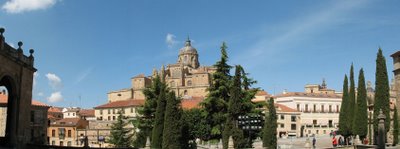The Priory of San Esteban (Secunda Pars)
 The Priory and Church is dedicated to St Stephen, the protomartyr and his Martyrdom (shown above) is depicted in stone at the centre of the great facade of the church, which is executed in the Plateresque style that dominates Salamanca.
The Priory and Church is dedicated to St Stephen, the protomartyr and his Martyrdom (shown above) is depicted in stone at the centre of the great facade of the church, which is executed in the Plateresque style that dominates Salamanca. This beautiful door on the left in honour of St Joseph leads from the cloister into the Priory church of San Esteban. Opening off the cloister are other elaborately carved portals in honour of various Dominican saints that lead to other parts of the convent. As with much of Spanish architecture and ornamentation, the shape of the door frame has a clear Moorish influence.
This beautiful door on the left in honour of St Joseph leads from the cloister into the Priory church of San Esteban. Opening off the cloister are other elaborately carved portals in honour of various Dominican saints that lead to other parts of the convent. As with much of Spanish architecture and ornamentation, the shape of the door frame has a clear Moorish influence.
The existing Church (on the right, showing the high altar and reredos and seen from the choir loft) was begun in the Feast of Ss Peter and Paul in 1524 by fray Juan Alvarez de Toledo, Cardinal-Archbishop of Santiago de Compostela. The Dukes of Alba were major benefactors and are buried in the church upon its completion in 1608. The church is 87 metres long, in the form of a Latin cross and rises to a height of 41 metres at the Crossing (below). The Crossing and the vault has beautiful bosses depicting the Coronation of the Virgin, Dominican saints and beati and the arms of Cardinal Alvarez.
 A marvel of the church is the beautiful Choir that is found in the west end, an arrangement quite typical of the churches used by the friars. The choir loft has 118 stalls for the friars and a central stall with a statue of St Dominic. The stalls are carved from walnut and were made between 1651 and 1655. In the centre of the choir is a splendid revolving lectern on which the enormous Office chant books were placed. The photo below shows a part of the choir with this lectern and a painting can be glimpsed above the choir stalls that depicts 'The Church Triumphant'. This is a wondrous work of allegorical art that shows the Order of Preachers serving the Church and the greater glory of God, helping the Church to trample error, ignorance and sin underfoot. More on this at a later date!
A marvel of the church is the beautiful Choir that is found in the west end, an arrangement quite typical of the churches used by the friars. The choir loft has 118 stalls for the friars and a central stall with a statue of St Dominic. The stalls are carved from walnut and were made between 1651 and 1655. In the centre of the choir is a splendid revolving lectern on which the enormous Office chant books were placed. The photo below shows a part of the choir with this lectern and a painting can be glimpsed above the choir stalls that depicts 'The Church Triumphant'. This is a wondrous work of allegorical art that shows the Order of Preachers serving the Church and the greater glory of God, helping the Church to trample error, ignorance and sin underfoot. More on this at a later date!
Returning to the cloister, we also visited the amazing Sacristy (below right).
 It sure beats the walk-in closet that serves as our sacristy here in Blackfriars Cambridge! Built in 1627 by fray Pedro de Herrera - bishop of the Canary islands and a son of this convent - the sacristy, taken as a whole, is considered the most representative work of the Baroque period in Salamanca. In one of the niches here was a statue of St Thomas Aquinas and the Spanish friar who was kindly acting as our tour guide said it looked rather like me! Would you agree with his assessment? Here it is on the left:
It sure beats the walk-in closet that serves as our sacristy here in Blackfriars Cambridge! Built in 1627 by fray Pedro de Herrera - bishop of the Canary islands and a son of this convent - the sacristy, taken as a whole, is considered the most representative work of the Baroque period in Salamanca. In one of the niches here was a statue of St Thomas Aquinas and the Spanish friar who was kindly acting as our tour guide said it looked rather like me! Would you agree with his assessment? Here it is on the left:
Finally, we re-emerged into the cloister and walking under the portal of St Peter Martyr we made our way out of the convent. The view from San Esteban is stunning. From the front of the church, one sees the east end of the Cathedrals of Salamanca. The city has two cathedrals - an old Romanesque one next to the larger new Gothic-Baroque cathedral - and it dominates the city together with the former Jesuit college which is now the Pontifical University. I leave you with this view of Salamanca Cathedral below. There will be more photos of the city and of our pilgrimage to Caleruega, Silos and Avila next week!


1 Comments:
I would like the publication of more photos or details of the choir of San Esteban de Salamanca. I am very interesting in this kind of religious furniture.
thanks.
Post a Comment
<< Home